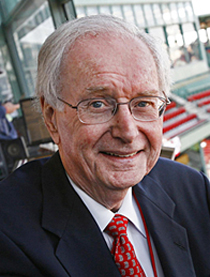
Culture
... "You can't tell the players without a scorecard?" Well, the Red Sox would be well advised to distribute scorecards in the dugout so the players will be able to figure out who is sitting next to them.

Flavin
Once April begins, the baseball games all count and the pressure gets turned on.
That's especially true this year at Fenway Park. None of us knows what to expect from this season's edition of the Red Sox. The team has been almost totally rebuilt and re-designed from the 2019 model, the last one to be around for a full season. Let's not even bother to count the 2020 version, which, if they ever made a movie of it, would be called "Nightmare on Jersey Street." Of the 2019 Red Sox starting rotation, David Price has been traded as part of the Mookie Betts disaster, Rick Porcello left via free agency and is now with the Mets, Chris Sale has undergone Tommy John surgery from which he is still recovering, Eduardo Rodriguez missed all of 2020 because of heart issues related to COVID-19, and Nathan Eovaldi spent half of 2019 on the injured list and ended up back on the list again last year. So, with Price and Porcello long gone, we are left hoping that Sale can make it back later this year, that Rodriguez's heart issues are behind him, and that Eovaldi can stay healthy for a season.
The bullpen has been almost totally revamped with the notable exception of Matt Barnes, whose record in six seasons with the Sox reminds one of the little girl from the nursery rhyme who had a little curl right in the middle of her forehead: "When she was good she was very, very good, and when she was bad she was ..." well, you know the rest.
The outfield, which we all thought, not so very long ago, was all set for years to come, has been completely overhauled -- Mookie is with the Dodgers, Jackie Bradley, Jr. is a Brewer, and Andrew Benintendi is out in Kansas City. In their places are a bunch of strangers.
First baseman Mitch Moreland is long gone. Second base is still being manned by committee, except that the committee members are new.
You know the old saying, "You can't tell the players without a scorecard?" Well, the Red Sox would be well advised to distribute scorecards in the dugout so the players will be able to figure out who is sitting next to them.
Manager Alex Cora, back from a year's sabbatical which was not his idea, will be under a great deal of pressure just to keep everyone's name straight in this production of "New Faces of 2021." The new faces which make up the cast will be under pressure, too, because it turns out that mother was right: first impressions are important. So we all hope the newcomers will stand up straight, wash behind their ears, and win some ballgames.
The guy who will really be under pressure won't be out on the field or even in the dugout; he'll be upstairs in the executive suite. Chaim Bloom, who inherited a messy situation when he took over as the head of baseball operations a year and a half ago is the architect of these new-look Red Sox. He came in with a mandate to get the team under the salary cap and do it in a hurry. The only way to do that was to trade Mookie Betts, a distasteful piece of business if ever there was one. He accomplished that while simultaneously getting rid of most of David Price's huge contract. He even got some real value in return in the person of Alex Verdugo plus a couple of prospects. The collapse of the pitching staff guaranteed that 2020 would be a lost cause, so Bloom began wheeling and dealing with this season in mind. Now it's here, for better or worse. We'll soon find out which it will be.
Red Sox fans are used to having superstars to root for, but that's not the case this year. The very first Red Sox team, called the Puritans in 1901, had as its ace Cy Young, the winningest pitcher in baseball history; he was followed by "The Gray Eagle," Tris Speaker, second only to Ty Cobb in star power during the dead-ball era; in his footsteps came the young Babe Ruth, then as famed for his pitching as for his powerful bat. When Ruth was sold to the Yankees by the treacherous Harry Frazee, the Sox were left without a star player or even a decent team for more than a decade. Then Tom Yawkey took over as owner and started by buying big name players Jimmie Foxx and Lefty Grove, and the Red Sox, bottom feeders since the days of Frazee, began to show signs of life. Then along came Ted Williams who dominated all of baseball until 1960. He was followed by Carl Yastrzemski, who preceded Roger Clemens; then it was Pedro Martinez and on to David Ortiz, who handed off to Mookie Betts. Now, no one. Oh sure, they've got some star players -- Xander Bogaerts, for example, but he's not in the superstar category. The Sox used to have one, but they shipped him to Los Angeles last year.
Some say that Bloom is taking a page from his previous employer, the Tampa Bay Rays, in structuring a team without big name stars, relying instead on a productive farm system and trading off their best players before they can negotiate expensive contracts. Bloom denies this, but it should be pointed out that the Rays are the only team he has ever worked for, having been hired shortly after graduating from Yale in 2005. Theirs is the only system he has ever known.
It should also be noted that the Rays' system works -- with one glaring exception. In recent years, they have fielded consistently good teams and they have done it with one of the lowest payrolls in baseball. They are missing only one key ingredient, though -- fans, for them, are few and far between.
In 2019, the last season before this that fans could attend games, the Rays had 96 regular season wins and made the playoffs (last year they made it all the way to the World Series), but they finished next to last in attendance, beating out only the lowly Miami Marlins.
Let's hope the Red Sox make a good first impression this year and get off to a fast start. They have a strong and a loyal fan base, but any significant dropoff in attendance or TV viewership could prove to be more expensive than it's worth.
- Dick Flavin is a New York Times bestselling author; the Boston Red Sox "Poet Laureate" and The Pilot's recently minted Sports' columnist.
Recent articles in the Culture & Events section
-
Scripture Reflection for April 14, 2024, Third Sunday of EasterDeacon Greg Kandra
-
St. Helena's House is established in the South EndThomas Lester
-
Is this synodality?Russell Shaw
-
Poking the hornet's nest of IVFFather Tadeusz Pacholczyk
-
A eucharistic word: MissionMichael R. Heinlein


















